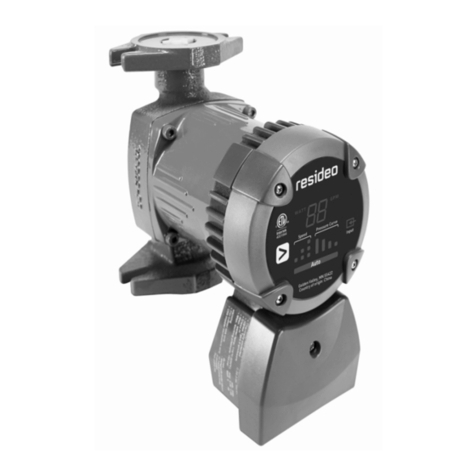
Translation of original - MU1H-1376GE23 R1020
Contents
1. Safety Guidelines............................................................................ 3
1.1 Safety instructions in this manual....................................................... 3
1.2 Safety instructions in the system........................................................ 3
1.3 General safety instructions................................................................ 3
1.4 Further safety regulations.................................................................. 3
1.5 Unauthorised operation types............................................................ 3
1.6 Software changes............................................................................. 3
1.7 Residual dangers in handling the compact booster unit ...................... 3
1 7.1 Mechanical residual dangers 4
1 7.2 Residual dangers pertaining to fluids 4
1 7.3 Residual electrical hazards 4
1 7.4 Residual biological hazards 4
1 7.5 Residual chemical hazards 4
1.7.6 Consequences and dangers that result from not observing the ma-
nual 4
1.8 Basic Safety Measures...................................................................... 5
1 8.1 Keep information available 5
1 8.2 For environmental protection 5
1 8.3 Modifications to the compact booster unit 5
1.9 Duty of due care of the operator ........................................................ 5
1.10Safety instructions for the operator/operating personnel ..................... 5
1.11Safety instructions for maintenance, inspections andassembly work .. 5
1.12Requirements for operating personnel ............................................... 5
1 12.1Operating personnel 5
1.13Personal safety equipment................................................................ 5
2. General information........................................................................ 6
2.1 Conformity with the following norms................................................... 6
2.2 Warranty and liability
......................................................................... 6
2.3 Storage and perfect condition............................................................ 6
2.4 Illustrations ....................................................................................... 6
2.5 Symbols ........................................................................................... 6
2.6 Other applicable documents.............................................................. 6
2.7 Glossary........................................................................................... 6
3. Description...................................................................................... 7
3.1 Overview .......................................................................................... 7
3 1.1 Installation type 7
3.2 Intended use..................................................................................... 7
3.3 Non-intended use.............................................................................. 7
3.4 Version............................................................................................. 8
3.5 Options............................................................................................. 8
4. Function.......................................................................................... 8
4.1 Inlet side........................................................................................... 8
4.2 Outlet side ........................................................................................ 8
4.3 Indicator LED.................................................................................... 8
4.4 Mode of operation............................................................................. 8
5. Technical data................................................................................. 9
5.1 Noise expectancy values................................................................... 9
5.2 Authorised environmental conditions ................................................. 9
6. Shipping........................................................................................ 10
6.1 Check condition upon delivery......................................................... 10
6.2 Transportation ................................................................................ 10
7. Assembly ...................................................................................... 10
7.1
General safety instructions...............................................................10
7.2 Installation according to EN1717......................................................10
7.3 Inspection before assembly .............................................................11
7.3.1 Installation site 11
7.4 Installing the compact booster unit ...................................................11
7.5 Installing the pipelines .....................................................................11
7.5.1 Connecting the overflow 11
7.5.2 Installing the compensator (optional) 11
7.6 Buffer tank ......................................................................................11
7.7 Installing valves...............................................................................11
7.8 Electrical connection........................................................................11
7.8.1Safety instructions 11
7.8.2Connection specifications 11
7.9 Standby indicator.............................................................................11
8. Start-up..........................................................................................12
8.1 Safety instructions for start-up..........................................................12
8.2 Start-up requirements......................................................................12
8.3 Initial operation................................................................................12
8. 3. 1
Change switch-on pressure 12
8.4 Switching the system on ..................................................................12
8.5 Start-up checklist.............................................................................13
9. Operation.......................................................................................13
9.1 Function of operating panel..............................................................13
10. Maintenance ..................................................................................13
10.1Safety instructions for maintenance..................................................13
10.2Inspection .......................................................................................13
10. 2. 1
Buffer tank 13
10. 2. 2
Monitoring Operation 13
10.2.3Checklist for Inspection 14
10.3Maintenance ...................................................................................14
10. 3. 1
Settingthe precharge pressure for the membrane pressure vessel
14
10. 3. 2
ning the dirt trap 14
10. 3. 3
Checklist for maintenance work 14
11. Troubleshooting............................................................................14
12. Shut-down, restart.........................................................................14
12.1Shutting down the compact booster unit ...........................................14
12.2Restarting the compact booster unit .................................................14
13. Storage ..........................................................................................14
13.1Short-term storage...........................................................................14
13.2Storage/Preservation.......................................................................14
13.3Storage conditions...........................................................................14
14. Disassembly, disposal ..................................................................15
14.1Safety instructions for disassembly...................................................15
15. Spare parts ....................................................................................15
16. Start-up protocol ...........................................................................16
17. Declaration of no objection ...........................................................17
18. Proof of Maintenance ....................................................................18
























